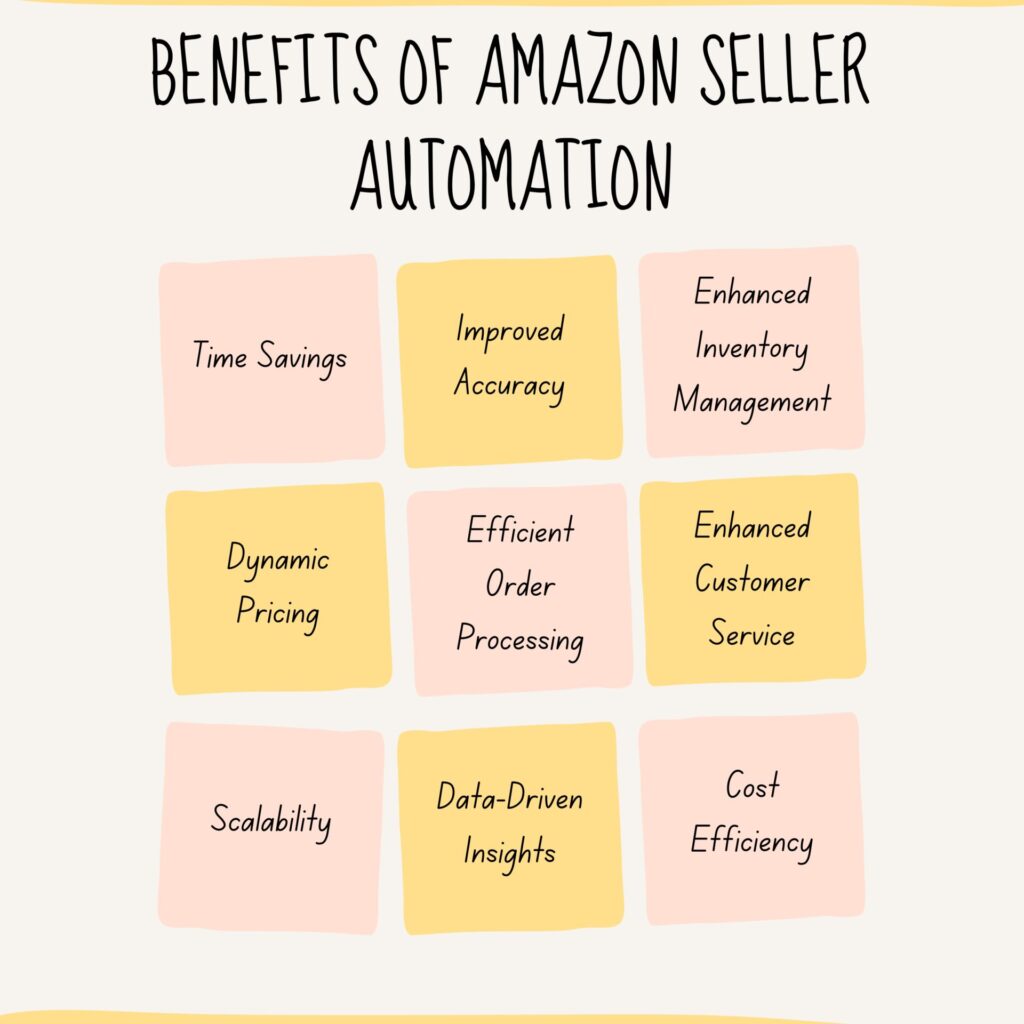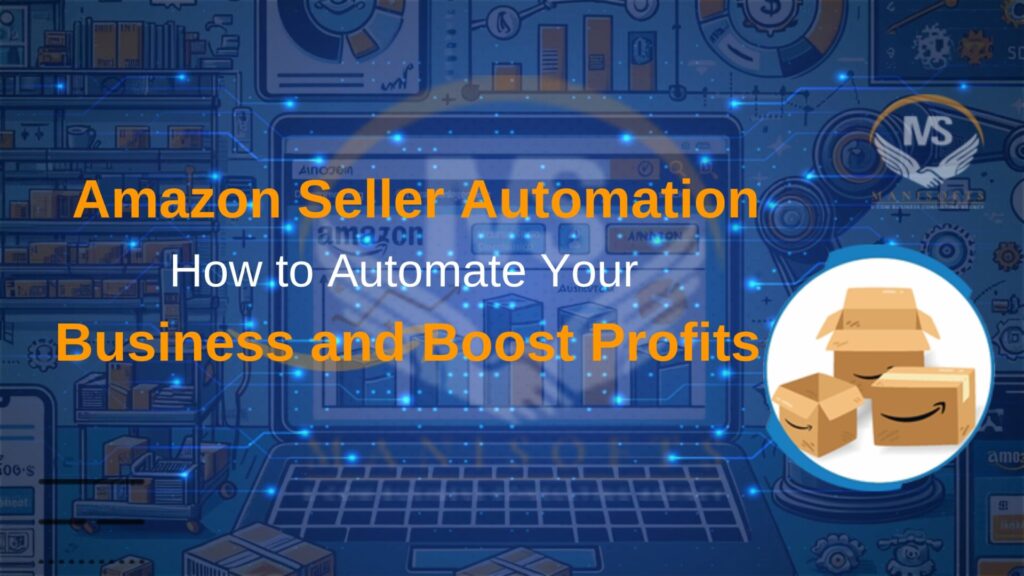Stop wasting hours on repetitive tasks like listing management and order fulfilment. Unlock the power of Amazon seller automation to skyrocket your productivity and profitability. Discover how to automate your business and take control of your time.
Introduction
Are you an Amazon seller drowning in a sea of repetitive tasks? Listing management, order fulfilment, inventory control – it can all feel like a never-ending cycle. But what if there was a way to free yourself from this daily grind and focus on what truly matters: growing your business?
This is where the power of Amazon seller automation comes in. By leveraging innovative tools and strategies, you can automate a significant portion of your daily tasks, streamlining your workflow and boosting your efficiency. Imagine the time you could save by automatically optimising your listings, sending personalised follow-up emails, or generating insightful reports.
In this article, we’ll delve into the world of Amazon seller automation, exploring its benefits, the key areas you can automate, and the best tools to get you started. Get ready to unlock a new level of productivity and watch your Amazon business soar!
Amazon seller automation
As an Amazon seller, managing various aspects of your business can be overwhelming. From keeping track of inventory to handling customer inquiries, the tasks can seem endless. Fortunately, Amazon seller automation tools can significantly streamline these processes, allowing you to focus on growing your business. Here’s a comprehensive guide on how automation can benefit your Amazon store.
1. Inventory Management
Effective inventory management is crucial for any e-commerce business. Automation tools can help you maintain optimal inventory levels, ensuring that you never run out of stock or overstock items. Here’s how:
- Real-Time Inventory Tracking: Automated systems provide real-time updates on inventory levels, alerting you when stock is low and needs replenishment.
- Automated Reordering: These tools can automatically place orders with suppliers when inventory reaches a certain threshold, ensuring you never run out of popular products.
- Warehouse Management: Some advanced systems integrate with your warehouse operations, optimising storage, picking, and packing processes.
2. Pricing Optimization
Staying competitive in the Amazon marketplace requires constant price adjustments based on market conditions. Automation tools can help you with:
- Dynamic Pricing: Automatically adjust prices in real-time based on competitor prices, demand fluctuations, and other market factors.
- Repricing Strategies: Implement various repricing strategies, such as undercutting competitors by a specific percentage or maintaining a certain profit margin.
- Price Alerts: Receive notifications when your competitors change their prices or when your products fall below a certain profit threshold.
3. Order Fulfillment
Efficient order fulfilment is key to maintaining customer satisfaction and ensuring repeat business. Automation can streamline this process by:
- Automated Order Processing: From order confirmation to shipping, automation tools can handle the entire order process, reducing the risk of human error.
- Shipping Integration: These systems can integrate with various shipping carriers, automatically selecting the best shipping options based on cost and delivery speed.
- Tracking and Notifications: Provide customers with real-time tracking information and automated shipping notifications, keeping them informed about their order status.
4. Customer Service
Providing excellent customer service is vital for maintaining a good reputation on Amazon. Automation can enhance your customer service efforts by:
- Automated Responses: Set up automated responses for common customer inquiries, such as order status, return policies, and product information.
- Chatbots: Use AI-powered chatbots to handle more complex queries and provide 24/7 customer support.
- Feedback and Reviews: Automate the process of requesting reviews from customers and responding to feedback, ensuring that you maintain a high seller rating.
5. Marketing and Advertising
Effective marketing and advertising are essential for driving traffic to your Amazon listings. Automation tools can help manage your advertising campaigns by:
- Campaign Management: Automate the creation and management of Sponsored Products, Sponsored Brands, and Sponsored Display ads.
- Bid Optimization: Automatically adjust bids based on performance metrics, ensuring you get the best return on investment.
- Keyword Targeting: Use automation to identify and target high-performing keywords, improving the visibility of your ads.
6. Review and Feedback Management
Positive reviews and feedback are crucial for building trust with potential customers. Automation tools can help you manage this process by:
- Review Solicitation: Automatically send out requests for reviews to customers after their purchase, increasing the likelihood of receiving positive feedback.
- Feedback Monitoring: Track customer reviews and feedback in real time, allowing you to address any issues promptly.
- Automated Responses: Set up automated responses to thank customers for positive reviews or address negative feedback constructively.
7. Analytics and Reporting
Data-driven decisions are key to the success of any business. Automation tools provide comprehensive analytics and reporting features, including:
- Sales Analytics: Track sales performance, identify trends, and understand which products are driving revenue.
- Inventory Reports: Gain insights into inventory turnover, stock levels, and reorder points.
- Customer Insights: Analyze customer behaviour, preferences, and buying patterns to tailor your marketing strategies.
- Market Trends: Stay informed about market trends and competitor performance, allowing you to adjust your strategies accordingly.
Benefits of Amazon Seller Automation
In the rapidly evolving world of e-commerce, staying competitive requires efficiency, accuracy, and the ability to scale operations seamlessly. Amazon seller automation has emerged as a vital tool for sellers aiming to streamline their businesses and maximise their potential. Here are some key benefits of integrating automation into your Amazon selling strategy:

1. Time Savings
One of the most significant advantages of Amazon seller automation is the considerable amount of time it frees up. Tasks such as inventory management, order processing, and pricing adjustments can be automated, allowing sellers to focus on strategic planning and other high-value activities. This time efficiency can lead to better business growth and improved customer service.
2. Improved Accuracy
Manual data entry and repetitive tasks are prone to human error. Automation minimizes these errors by ensuring that tasks are performed consistently and accurately. This precision is crucial for maintaining accurate inventory levels, processing orders correctly, and managing financial records, all of which contribute to a smoother operation.
3. Enhanced Inventory Management
Automated systems can monitor inventory levels in real time, alerting sellers when stock is running low or when it’s time to reorder. This proactive approach prevents stockouts and overstock situations, helping to maintain optimal inventory levels. Better inventory management leads to increased sales and customer satisfaction.
4. Dynamic Pricing
Competitive pricing is essential for success on Amazon. Automation tools can adjust prices based on market trends, competitor prices, and demand fluctuations. This dynamic pricing strategy ensures that your products are always competitively priced, helping to attract more buyers and increase sales.
5. Efficient Order Processing
Automated order processing streamlines the fulfillment process, from receiving orders to shipping them out. This efficiency reduces processing times, ensures timely deliveries, and enhances customer satisfaction. Quick and reliable order processing can lead to positive reviews and repeat business.
6. Enhanced Customer Service
Automation tools can handle routine customer service inquiries, such as order status updates and return requests. By automating these interactions, sellers can provide prompt responses to customers, improving their overall shopping experience. Happy customers are more likely to leave positive feedback and become repeat buyers.
7. Scalability
As your Amazon business grows, managing operations manually becomes increasingly challenging. Automation allows for seamless scaling by handling larger volumes of inventory, orders, and customer interactions without compromising efficiency. This scalability is essential for expanding your business and reaching new markets.
8. Data-Driven Insights
Automated systems can collect and analyze vast amounts of data related to sales, customer behavior, and market trends. These insights enable sellers to make informed decisions, optimize product listings, and develop effective marketing strategies. Data-driven decision-making can lead to higher profitability and business growth.
9. Cost Efficiency
While there is an initial investment in automation tools, the long-term cost savings are substantial. Automation reduces the need for manual labor, minimizes errors, and enhances operational efficiency. These cost efficiencies can lead to higher profit margins and a stronger competitive position in the market.
Price Optimization and Repricing Automation
In the competitive world of e-commerce and retail, staying ahead of the curve is essential for success. One of the most effective strategies to achieve this is through price optimization and repricing automation. These concepts are integral to maximizing profits, improving market competitiveness, and ensuring customer satisfaction.
Understanding Price Optimization
Price optimization involves setting the ideal price for products or services, balancing multiple factors such as production costs, market demand, competitor prices, and customer willingness to pay. By analyzing historical sales data, market trends, and consumer behavior, businesses can determine the most profitable pricing strategy.
Effective price optimisation requires sophisticated algorithms and machine learning models that continuously evaluate data to predict the best price points. This dynamic approach allows businesses to adjust prices in real time, adapting to market changes and seasonal fluctuations.
The Role of Repricing Automation
Repricing automation takes price optimization a step further by automating the process of adjusting prices. Using advanced software tools, businesses can set rules and parameters for price changes based on competitor pricing, inventory levels, and market demand. These tools continuously monitor the market and automatically adjust prices to maintain a competitive edge.
For instance, if a competitor lowers their price on a similar product, repricing automation can instantly respond by adjusting your prices to stay competitive. This ensures that your offerings remain attractive to potential buyers without the need for constant manual intervention.
Benefits of Price Optimization and Repricing Automation
- Increased Revenue: By continuously adjusting prices to the optimal level, businesses can maximise their revenue potential. This is achieved by capturing the highest possible price that customers are willing to pay at any given time.
- Enhanced Competitiveness: Staying competitive in a crowded market is crucial. Repricing automation ensures that your prices are always in line with or better than your competitors, helping you attract more customers and retain market share.
- Improved Efficiency: Automating the repricing process saves valuable time and resources. Instead of manually monitoring and adjusting prices, businesses can rely on automated systems to handle these tasks, allowing employees to focus on other strategic activities.
- Better Customer Satisfaction: Optimized pricing can lead to better customer satisfaction. When prices are fair and competitive, customers are more likely to make purchases and return for future transactions.
- Data-Driven Insights: Both price optimization and repricing automation rely on data analysis. This provides businesses with valuable insights into market trends, customer behavior, and the effectiveness of different pricing strategies.
Challenges and Considerations in Amazon Seller Automation
Selling on Amazon has become increasingly competitive, leading many sellers to turn to automation tools to streamline their operations and enhance efficiency. While automation can significantly benefit Amazon sellers by saving time and optimizing processes, it also comes with its own set of challenges and considerations. Understanding these aspects is crucial for leveraging automation effectively and maintaining a successful Amazon business.
Key Challenges in Amazon Seller Automation
- Complexity of Setup: Implementing automation tools can be complex and time-consuming. Sellers must configure various settings, integrate multiple systems, and ensure that all automation workflows function correctly. This initial setup requires a deep understanding of both the automation tools and the Amazon platform.
- Data Accuracy and Integrity: Automation relies heavily on accurate data. Any errors in inventory levels, pricing, or product information can lead to significant issues, such as stockouts, overstocking, or incorrect pricing. Ensuring data accuracy is critical to prevent costly mistakes and maintain customer trust.
- Adherence to Amazon’s Policies: Amazon has stringent policies and guidelines that sellers must follow. Automation tools need to comply with these rules to avoid account suspension or penalties. Sellers must stay updated on policy changes and ensure that their automation processes do not violate any of Amazon’s terms.
- Integration Challenges: Many sellers use multiple tools and platforms to manage their business. Integrating these systems with Amazon seller automation tools can be challenging, often requiring custom solutions or additional software to bridge gaps. Seamless integration is necessary for efficient and error-free operations.
- Managing Multiple Marketplaces: Sellers who operate in multiple Amazon marketplaces must manage different regulations, currencies, and customer preferences. Automation tools need to be adaptable and capable of handling the complexities of various marketplaces, which adds another layer of difficulty.
- Cost of Automation Tools: High-quality automation tools can be expensive. Sellers need to weigh the costs against the potential benefits and ROI. It’s important to choose tools that offer scalability and flexibility without overburdening the business financially.
Considerations for Effective Amazon Seller Automation
- Selecting the Right Tools: Carefully evaluate different automation tools based on your specific needs and business goals. Look for features such as inventory management, repricing, order processing, and customer service automation. Popular tools include SellerLabs, Sellics, and Jungle Scout.
- Customizing Automation Workflows: Customize your automation workflows to fit your business processes. Avoid a one-size-fits-all approach by tailoring automation settings to address your unique challenges and optimize performance.
- Regular Monitoring and Updates: Automation is not a set-and-forget solution. Regularly monitor automated processes to ensure they are functioning correctly. Update your tools and workflows to accommodate changes in your business or Amazon’s policies.
- Ensuring Data Security: Protecting your business data is crucial. Use reputable automation tools that offer robust security measures to safeguard sensitive information. Regularly back up your data to prevent loss or corruption.
- Training and Support: Provide adequate training for your team on how to use automation tools effectively. Leverage customer support and resources offered by the tool providers to troubleshoot issues and optimize usage.
- Scalability: Choose automation tools that can grow with your business. Ensure the tools can handle increased volumes of inventory, orders, and customer interactions as your business expands.
- Compliance and Adaptability: Stay compliant with Amazon’s policies and adaptable to changes in the marketplace. Regularly review and adjust your automation strategies to remain aligned with Amazon’s evolving guidelines and market trends.
FAQ’s
Amazon automation enables the streamlining of repetitive tasks, enhancing both front-end and back-end processes. This includes activities like product research, order processing, pricing strategies, and listing management.
To buy an Automated Ecom Profits franchise, you need at least $40,000 in available funds. This investment gives you a fully automated business that generates passive income.
Examples of automated tasks on Amazon include managing inventory and shipping through Fulfillment by Amazon (FBA), using chatbots for customer service, employing sales forecasting tools, optimising marketing campaigns with third-party services like Pacvue, and adjusting prices with repricing tools.
Many automation tools are designed to integrate seamlessly with existing systems, such as customer relationship management (CRM) software, email platforms, and other e-commerce tools, making it easier to manage your Amazon store.
While automation can greatly improve efficiency, it also carries risks such as data inaccuracies, potential policy violations, and integration challenges. It’s important to monitor automated processes to mitigate these risks regularly.
Conclusion
Amazon seller automation offers a powerful solution for streamlining various aspects of managing an Amazon store. By leveraging automation tools, sellers can significantly enhance their efficiency, reduce manual workload, and focus more on strategic growth activities. Automated systems manage tasks such as inventory control, order processing, customer service, pricing adjustments, and marketing optimization, allowing for a more consistent and scalable business operation.
However, it’s essential to recognise and address the challenges that come with automation, including the complexity of setup, ensuring data accuracy, maintaining compliance with Amazon’s policies, and the need for seamless integration with existing systems. With careful planning, continuous monitoring, and regular updates, sellers can effectively navigate these challenges.
Investing in the right automation tools tailored to your business needs can lead to substantial improvements in productivity and profitability. As the e-commerce landscape continues to evolve, staying ahead of the competition with smart automation strategies will be crucial for the sustained success of Amazon.




